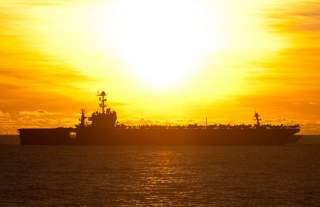China is Waging a Maritime Insurgency in the South China Sea. It's Time for the United States to Counter It.
The rule of international law will stand or fall on the confidence of civilian mariners to operate where and how they please within the boundaries of their international legal rights.
To truly contest China’s insurgent gambit for de facto and in the future likely de jure sea control, the United States must think and operate like a counterinsurgent in the South China Sea, exercising its influence against the Chinese insurgent through the protection of the far more constant and persistent presence of local civilian craft. If the United States can successfully protect such vessels from Chinese interference in their operations in those areas of the South China Sea, which are within the bounds of international law, and if the United States can successfully regularize such operations as to create a new status quo, then the Chinese would functionally be compelled to respect civilian freedom of navigation, and their bid for de jure terrestrial-style sovereignty over the South China Sea would be dealt a grievous blow.
Such a maritime counterinsurgency campaign would not necessarily alter the overall military balance in the South China Sea, which would continue to favor China by virtue of its sheer geographic proximity. The challenge facing the forces executing maritime counterinsurgency would be one of defending freedom of navigation and international law from a standpoint of local military inferiority. It may seem initially counterintuitive, but so long as China is unwilling to shoot U.S. escort forces out of the way and thereby risk a monumentally destructive war just to harass a group of civilian vessels under American protection, the local imbalance of high-end warfighting forces would be largely irrelevant.
With the right operational methods, the commitment of a sufficient but sustainable level of resources to the task, and the requisite national will to maintain this effort over a protracted period—for the necessary element of all successful counterinsurgencies is not so much force numbers as it is time—a maritime counterinsurgency campaign in the South China Sea coupled with vigorous diplomacy could achieve an essential victory for U.S. and allied arms and the rules-based international order they defend. This endeavor will require, among other things, an interagency, agile and cohesive planning process to coordinate with allies; the ability to integrate military and political means to prepare for different potential responses; and above all to hold true to the objective until such time when China recognizes the wisdom of accepting the freedom of the sea that has profited it so well over the past seven decades and abstains from coercive actions. It could well take years, even decades, but the struggle will be a worthy one, waged for a cause vital to the national and international interest.
Dr. Patrick M. Cronin is senior director of the Asia-Pacific Security Program at the Center for a New American Security (CNAS) and the former director of the Institute for National Strategic Studies at the National Defense University.
Hunter Stires is a fellow at the John B. Hattendorf Center for Maritime Historical Research at the U.S. Naval War College and Adjunct Affiliate for Maritime Strategy at CNAS.
Image: The aircraft carrier USS George Washington (CVN 73) steams through the South China Sea July 8, 2012. George Washington was under way conducting maritime security operations and theater security cooperation efforts in the U.S. 7th Fleet area of responsibility. Flickr / U.S. Department of Defense

